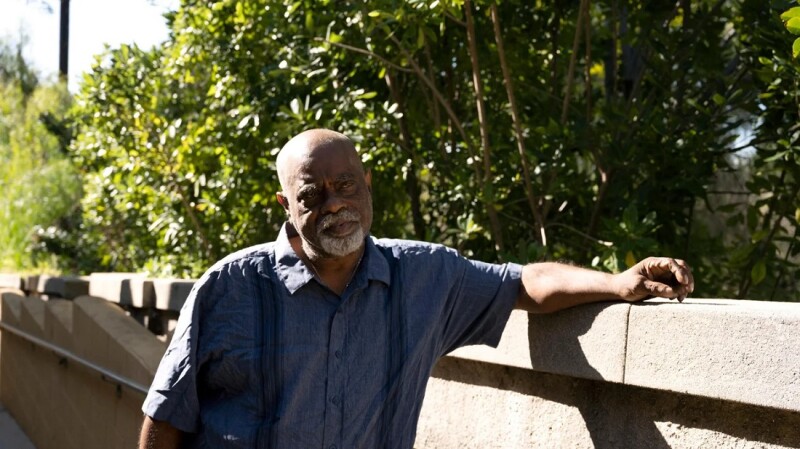“You’d never know it by looking at it,” said Don Martin as he faced a tall green wall decorated with a row of bushes. “A danger that’s hidden from view.”
Beyond the wall is the Murphy Site, an active oil drilling project operated by E&B Natural Resources that uses chemicals residents believe are contributing to sinister health problems. For 12 years, Martin has lived next door alongside dozens of families in a yellow low-income housing complex with a basketball court and playground.
Located in the West Adams neighborhood of south Los Angeles, the drill site is surrounded by a senior’s home and a medical clinic for AIDS patients. Three schools stand a block away.
The site is wide open, allowing emissions to waft into the air. Martin’s apartment is about 200 ft from the wall. A sign on the gate reads: “Warning: this area contains chemicals known to the state of California to cause cancer or birth defects or other reproductive harm.”
His wife was diagnosed with brain cancer, and his granddaughter had Hodgkin’s lymphoma. “I think it’s all related to this sign,” he said.
His granddaughter was 8 when she had an operation to remove a tumor in her chest and endured chemotherapy. Her hair fell out, she felt nauseated, and she was too exhausted to play with friends. Martin told her the oil site was to blame, and she asked him why they didn’t move. “This is low income, we got nowhere to go,” he said he told her.
She is now in remission, but his wife—his high school sweetheart and spouse of 50 years—didn’t survive. “I sat there and held her hand and watched her die. That’s something I got to deal with the rest of my life.”
Like Martin and his neighbors, there are 40,000 oil fields globally with 6 million people living and working nearby, according to a 2019 study that found oil and gas development is associated with cancer, liver damage, immunodeficiency, and neurological symptoms. Oil and gas development emits benzene and formaldehyde, both carcinogens. The drilling also emits methane, a potent greenhouse gas that increases global heating.
Los Angeles is home to the largest urban oil field in the US, and about 1,000 active oil and gas wells are sprinkled across the city, next to hiking trails, homes, and schools. In Los Angeles County, half a million people live within 1,320 ft of more than 5,000 oil and gas wells, according to a 2014 report; and Latino, African American, and Asian American residents are more likely than white residents to live near oil and gas wells. Statewide, people of color made up 92% of the 1.8 million people living within a mile of an oil and gas site, the same report found.
Yet California is one of the few oil-and-gas-producing states without minimum distance requirements between homes and fossil fuel sites, according to a 2020 analysis. Maryland has the largest distance requirements, at 1,000 ft. Pennsylvania requires 500-ft setbacks from unconventional oil and gas wells. Arkansas has the smallest setbacks, at 100 ft. Other states, like Washington and New York, have banned hydraulic fracturing entirely.
Now, after more than a century of fossil fuel production in California, the tide is turning.
On 2 December, the Los Angeles city council passed an ordinance to phase out oil and gas drilling. In September, the Los Angeles County board of supervisors passed a similar ordinance to phase out drilling in unincorporated areas. In September, governor Gavin Newsom signed a law, SB-1137, that goes into effect 1 January 2023, banning new oil and gas drilling within 3,200 ft of homes and schools—the largest setback requirement of any state. The new laws recognize that fossil fuel extraction contributes to climate change while also harming residents who are primarily Black, Indigenous, and people of color. The Biden administration has also promised funding to clean up drill sites.
The California Independent Petroleum Association is fighting the state law by gathering signatures for a petition to “Stop the Energy Shutdown.” In fact, the petition asks for a referendum on SB-1137, which could slow or stop the law.
Martin is skeptical that the new laws will have an immediate impact. While the city will no longer issue new drilling permits, some companies will have 20 years to wind down their activities.
“We’ll be long dead before they phase those sites out,” he said. “If you’re going to do something, stop it now.”

